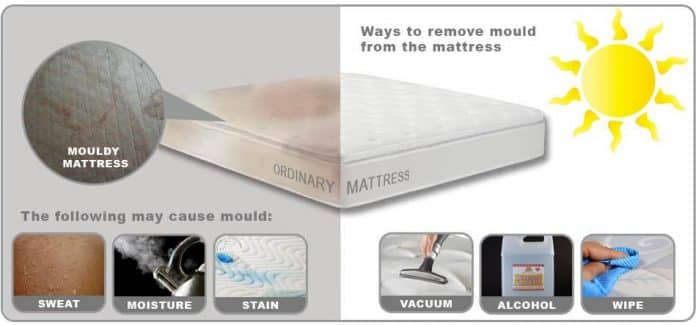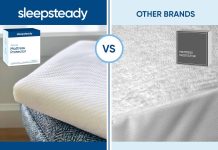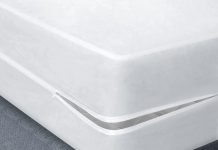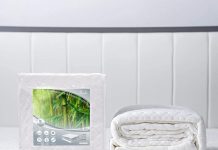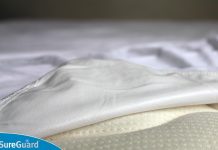Mold is both disgusting and difficult to remove. Mildew growth occurs in damp environments like the kitchen, garden, and bathroom.
It might be damaging to your health. Do you know that mold can grow on your mattress if your mattress is damp? That is scary.
The fungus may grow inside or out, but when it grows on bedding, such as mattresses, pillows, or comforters, it can cause respiratory problems and other health issues.
We will answer all your mold-related questions in this article and show you how to identify them. We will also offer advice on how to handle this pesky pest.
Review contents
Causes Of Mold’s Growth On A Mattress
Mold may form on mattresses for a variety of causes. Mold may build on your bed even though you are the cleanest person.
Constantly moist environments may promote mold growth. In addition, you cannot control the weather. Mold can grow in those environments where the water supply is in excess.
Breeding Ground For Mold:
As humidity and the environment cause mold, mold-free mattresses are impossible. Any foam is a prime breeding ground for mold.
Airborne Mold:
It is possible to see the mold when it has matured, but its reproductive system cannot. In addition to causing respiratory problems, this can also cause health problems.
Thrives in Dark And Moist Conditions:
A dark, moist environment is all mold needs to thrive. Mold might succeed in the right environment, which could be your mattress. Sweat includes all of the humidity required for mold to develop.
Read Next – Memory Foam Camping Pad
Symptoms Of A Moldy Mattress
Mold or mildew is so tiny that you will not notice it. But they can be seen from a magnifying glass or microscope if they grow larger.
It is expected to observe little black spots under the mattress as mildew early signs are long before you develop any health issues or smell a stench. This problem is prevalent among those who don’t regularly change their sheets.
Filthy Smell From Mattress:
Mold spores have a distinctive odor. Mold on a mattress has a musty smell that you may overlook until the problem has progressed.
It smells like decaying food and has a fuzzy appearance. It is important to address mold right away. If left untreated, it might lead to serious health problems.
Bugs In Your Mattress:
Spiders suddenly appearing near your bed could indicate an infestation. They feed on the bugs that live in your bed. Thus, they are invading.
They are attracted to the odor of mold. Furthermore, the smell may draw termites to the bed. This is why bugs in your bedroom that don’t have bed bugs might signify fungus growing within your mattress.
The Appearance Of A Filthy Mattress:
Mold appears as black spots on the mattress or bed slats when it comes into contact with the ground. Mold appears as a fuzzy coating in large white or black chunks, recognizable by its dotty and black appearance, which is unique to this type of fungus. If you don’t adopt the preventive measures for the mold, it will spread and cover the mattress, causing damage and creating spores that can harm your health.
Spots On Bed:
Mold growth is probably responsible for any black stains on your mattress. Mildew is most likely present if the spots match other colors.
Read NEXT – Milddreams Waterproof Mattress Protector Cover
Blemish On The Bed:
Not all molds cause unique black streaks. Green and purple spots might result from mold waste products. Ideally, mold is most likely to be blamed if washing the discolored areas with vinegar or enzymatic cleaners does not solve the problem.
If you have removed all blood and feces stains, it might be mold, but still observe a brown, brownish, or black spot.
Health Concerns:
Spore exposure is not healthy for most people, especially those already sick or who suffer from severe allergies. Mold may induce headaches, shortness of breath, and anxiety when it grows in mattresses. You may guess you did not have a good night’s sleep if you woke up weary and had a tight head, joints, and muscles.
The bed is where you spend the most time compared with other rooms. Fungus particles emit toxins that settle on furniture and bedding and cause unpleasant symptoms like fatigue and headaches.
Read Next – How to Choose Mattress Protector
How To Prevent Mold Under The Mattress
Do you want to know how to prevent mold under the mattress? Drying your bed thoroughly is the Drying your bed thoroughly is the way to keep it from mold and mildew really; you should not leave your bed wet for days or weeks because mold and mildew love moisture. Inhaling the microscopic spores in the air can bring mold and decay into a room when they float around.
If it gets into our lungs and respiratory system (nasal passages, throat), we get sick with allergies or other breathing-related conditions like bronchitis or pneumonia.
Therefore, try to avoid sleeping on a damp mattress as much as possible. Avoid wearing wet clothes before going to bed. Change the clothes and let them dry in the sun. Let the sheets air in direct sunlight after taking off the mattress.
If there is no sun today, use a fan or an electric heater to speed up drying. Put the sheets and duvet back on when it feels dry. I’m going to bed tomorrow night.
How To Remove Mold From Mattress
Mold can be treated in many ways, but none is more effective than bleach. Cleaning the mattress with eggs and other cleaning products may seem efficient in removing mold, but it can be incredibly damaging to your health.
It still won’t leave a pleasant smell when used on mattresses, but it certainly beats the alternative. For a good indication of what can happen if you don’t use bleach, let’s look at the steps below to remove mold from your mattress with bleach.
Remove The Mattress From Its Frame and lay It On A Flat Surface:
● Take care to protect surrounding furniture, flooring, and carpeting by placing plastic or old sheets on the ground.
● In a spray bottle, combine one part bleach and eight parts water. After thoroughly wetting the mold patches, let them soak for 15 minutes.
● Next, use your hands or an old scrub brush to vigorously rub off any visible mold stains. If there are extensive mold areas, scrascrapingdge (such as a table scraper) may be helpful before scrubbing.
Use may be helpful A Vacuum To Remove Any Loose Mold Or Debris:
● Drying the mattress by using a fan is compulsory for its removal. If you want, you can cover it with a mattress cover once it has completely dried.
● A bit of an odor will inevitably linger after bleaching a mattress, but it will dissipate over time like any other fabric. Contact a professional cleaner in your area for more information on cleaning a mattress specifically.
● When cleaning up mold in your home, remember that children and pets can be sensitive to its irritants, so take care when working around these individuals!
Spray Baking Soda With Water:
● Mix all ingredients thoroughly in the bottle by shaking it.
● Pour the baking soda mixture onto all affected areas of your mattress. You can use an old brush or sponge to work it into mold stains and let it sit overnight.
● After the treatment, remove all the debris or powder from an old cloth or sponge, then allow the entire surface of the mattress to dry completely. If some parts remain moist for more than four hours, you may need to repeat this process until no residue remains.
● These methods will work well, but I would choose the first one. I was surprised that you can use baking soda and bleach together!
CONCLUSION
Mold may develop in practically any environment. The spores are hazardous and can cause serious health issues. Choosing a mattress protector and a mattress to combat decay is essential.
Vacuuming and airing your mattress is essential, as is avoiding resting on it before bathing. If you spill something, wipe it up immediately and allow it to dry entirely before recovering the space.
If you really must have a memory foam mattress, carefully follow the maintenance instructions and expose the bed to direct sunlight at least once a month to be safe.
Read Next – Utopia Bedding Premium Zippered Waterproof

